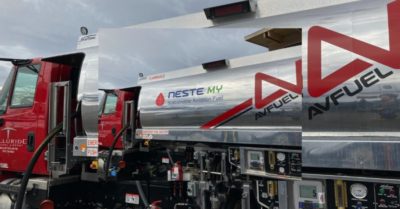It’s hard to imagine a carbon neutral world without considering airplanes. Commercial aviation contributes about 2.5% of annual global CO2 emissions from fossil fuel use. But, as KOTO’s Matt Hoisch explains, some airports are finding ways to bring down that number.
Listen:
-
play_arrow
Getting Green Fuel Up, Up And Away Alexis Kenyon
A plane is refuelling on the tarmac at the Telluride Regional Airport (TEX). It might be hard to tell just from looking, it’s also reducing its carbon emissions. That’s thanks to a change the airport made last year when it began integrating sustainable aviation fuel—or SAF—into its operation.
“I guess a simple way to explain it is, its nonpetroleum,” says Kenneth Maenpa, Airport Director for TEX. “You’re not using oil. You’re using vegetation. You’re using used vegetable oils, those kinds of things, into the manufacture of this fuel.”

According to Maenpa, Telluride is one of two airports in Colorado using the fuel. SAF has a lot of upsides. It can reduce aviation emissions by up to 80%. And it’s interchangeable with conventional fuel, which helps on the equipment front.
“You don’t have to change your infrastructure,” he says. “You don’t have to have a separate tank or anything else.”
But there is a downside. “It’s very expensive,” Maenpa says.
Supply is one factor contributing to that cost. SAF is very limited in the U.S. That’s according to Richard Thacker, Director of Integration and Operational Strategy at Atlantic Aviation, a company that services providers across the country.
“That’s the real challenge with SAF right now,” Thacker says. “It’s not particularly new technology. But it’s very, very limited in quantity. And so, it’s very difficult to get it to markets, especially in the interior portion of the country.”
Demand is another factor. A lot of airports, according to Thacker, are asking for SAF.
“The requests are coming from coast to coast,” Thacker explains. “And the answer is always the same: we’re doing our best to get our hands on as much supply as we possibly can, but right now it’s very limited.”
That limited supply also complicates the green aspect of the fuel. Atlantic sup
plies SAF to Aspen-Pitkin County Airport, the other spot in Colorado using it. Thacker notes they had to be very thoughtful about transporting the fuel almost 1200 miles to the mountain town.
“We didn’t want the headline to be ‘Dirty Truck Delivers Clean Fuel,’” Thacker says. “So, we made sure that the transport trucks were using renewable diesel to transport the product. And then we did the equation on that and made sure the carbon benefit—or losing the carbon benefit on the SAF was minimal. And it was.”
Several major airlines, including United and British Airways have used SAF. And there’s a chance supply—and therefore cost—will be less of an issue in the future. Last year the Biden administration announced a goal to ramp up domestic SAF production from the current level of roughly 4.5 million gallons per year to three billion by 2030.

Dr. Tracey Dodd thinks that sort of top-down push is essential to make aviation green. Dodd is a researcher at the Adelaide Business School in Australia, who focuses on decarbonization.
“We wouldn’t have renewable electricity if it wasn’t for government intervention,” Dodd notes.
“And I think airlines have been left holding the baby on this one, and everyone needs to get behind and support them.”But Dodd also stresses more attention from governments starts with more focus from the public.“People are not completely aware of the environmental impact of flying or that there are other options available,” she says.
“And so, we need to increase awareness of that. And by doing that, legislators have a stronger mandate to increase regulation which supports business.”Along the way, Dodd adds, it’s important not to greenwash and overstate the environmental benefits of existing green options.
“I feel if you were to look at a whole range of websites around sustainable aviation fuel you would have a false sense of security that things are looking good, this is all positive, we can be carbon neutral, we don’t have to make this tradeoff,” Dodd says. “I think that that’s not helpful in the community conversation.”
Current SAF, Dodd notes, doesn’t eliminate carbon from aviation completely. So carbon neutral flying will take more innovation and leadership. But Dodd also says she’s optimistic that by 2050 she’ll be able to fly on a plane and produce little to no carbon emissions.In the meantime, Maenpa says the Telluride Regional Airport aims to increase its SAF usage over the next decade. The airport currently uses a fuel blend that’s about 30% SAF.
“So, if we can just keep increasing that, if manufacturing can scale up, we’re first in line,” Maenpa says. There’s certainly no shortage of incentives. As climate change intensifies, a warmer world could dent the winter and summer tourism ecosystem that draws planes and passengers to the airport in the first place.
-
play_arrow
Getting Green Fuel Up, Up And Away Alexis Kenyon
Podcast: Play in new window | Download


















